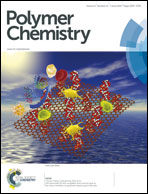Synthesis of polystyrene with cyclic, ionized and neutralized end groups and the self-assemblies templated by breath figures†
Abstract
Polymers with functional end groups were synthesized via atom transfer radical polymerization (ATRP) using a novel cyclic lactone initiator, which can be facilely converted into ionized and neutralized groups by hydrolysis and acidification processes, respectively. Results from Fourier transform infrared (FTIR) and 1H and 13C nuclear magnetic resonance (NMR) spectroscopies indicate that the cyclic lactone end group can be fully converted into sodium carboxylate in alkaline solution whereas the acidification process induces both neutralization and esterification. Gel permeation chromatography (GPC) curves reveal intramolecular esterification instead of intermolecular esterification during the acidification process. The polymers with various end groups that show different hydrophilicities were then utilized to fabricate honeycomb-patterned porous films by the breath figure method. Polystyrene with an ionized or neutralized end group forms highly ordered self-assembled films in an easy and reproducible way, whereas that with a less hydrophilic lactone end group generates irregular films. Moreover, polystyrene with an ionized end group, which is the most hydrophilic, results in porous films with a multilayered structure and a much smaller surface pore size (it decreases to ∼610 nm from 1.8 μm for films prepared from the neutralized polymer). In addition, we found that the end-functionalized polystyrene with a very low molecular weight (∼2960 g mol−1) is able to form highly ordered honeycomb films. It is speculated that the ionized end group endows polystyrene with high interfacial activity, leading to the unique surface morphologies. This is evidenced from the results of water contact angles on film surfaces with a pincushion structure obtained by removing the top surface layer. The proposed approach to well-controlled end-functionalized polymers is useful in the fabrication of self-assemblies with adjustable morphologies.


 Please wait while we load your content...
Please wait while we load your content...